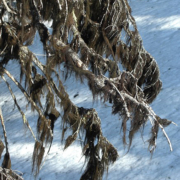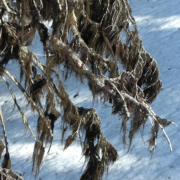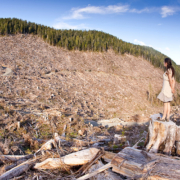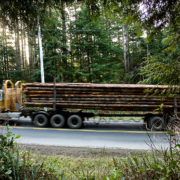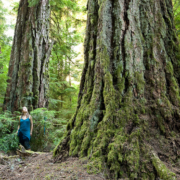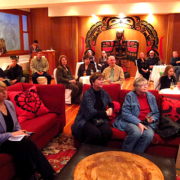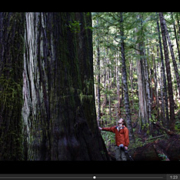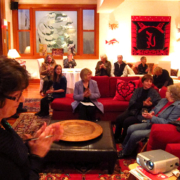New Species Name to be Auctioned-off as Fundraiser for the Ancient Forest Alliance!
/in News Coverage/by TJ WattCurrent Highest Bid:
$3,750 – Click here to top this bid at the Charity Buzz online auction!
Previous Bids
$500 – Matt Breech, Vancouver
$350 – Jean Johnson, Sidney
$300 – Jenn Chow, Vancouver $250 – Anonymous
$100 – Stu Crawford, Vancouver
Here’s your chance to name a new species and help protect the spectacular, endangered ancient forests in British Columbia, Canada!
The scientific naming rights to a newly discovered species of lichen are being auctioned-off as a fundraiser for the Ancient Forest Alliance, a British Columbian non-profit conservation organization.
Canadian botanical researcher Trevor Goward discovered the new species of bryoria or “horsehair lichen” in the inland temperate rainforest of British Columbia. Goward is donating the naming rights for the new species to the Ancient Forest Alliance to help the organization raise funds for its conservation campaigns – and to help create a model to encourage other taxonomists around the world who discover new species to donate their naming rights to conserve endangered species and ecosystems!
WHY Should YOU Make a Bid for this New Species?
1. Your name would be enshrined as a legacy that could endure as long as our civilization lasts!
Having your name – or that of a loved one, your favourite celebrity, role model, hero, sports team – linked to a living species is a legacy that lasts a long time. It has been almost three centuries since the modern system of biological classification was developed by Carolus Linnaeus; and even now the names of people after whom he christened various plants and animals are still with us. With any luck your name will endure as long as our civilization does. Not even Shakespeare could hope for more than that!
2. It will help set a precedent for a potentially successful new way to raise millions of dollars for conservation around the world!
Thousands of new species are described by taxonomists every year. If this fundraiser is successful, it will help to create a model that could convince other taxonomists to support conservation organizations, raising millions of dollars for conservation around the world for the Earth’s diverse ecosystems and biodiversity!
3. You will greatly help British Columbia’s leading – and leanest – environmental organization working at the forefront of the campaign to protect British Columbia’s endangered old-growth forests.
The old-growth forests of British Columbia are among the most magnificent forests on the planet, harbouring trees with trunks as wide as living rooms and that tower as tall as downtown skyscrapers. These forests are home to some of the largest and most charismatic animal species on Earth, including grizzly bears, mountain lions, wolves, and mountain caribou, and some of the most endangered species, like the spotted owl and white-headed woodpecker.
The Ancient Forest Alliance has generated huge media coverage, public awareness, and policy influence in less than 2 years since its founding – with only a tiny fraction of the funding base compared to other major environmental organizations. The organization has built vital new support among tourism businesses, First Nations, politicians, forestry workers, and a large diversity of citizens that will ultimately lead to success if the campaign is adequately funded.Media Release
Those who want to make a bid to have one of the new species named after themselves or a loved one should visit
or contact The Land Conservancy at www.conservancy.bc.ca/ or phone 1-877-485-2422.
B.C. isn’t doing enough to preserve its forests
/in News Coverage/by TJ WattOne month ago, six Orca whales -black and white, beautiful, and in the mood to show off their swimming skills -showed up in Burrard Inlet. Two weeks ago I saw a mother grizzly bear and her two cubs emerge from the woods to forage beside a gorgeous northern river. These sorts of experiences make B.C. special -they are but dreams for most of the world.
Orcas vacation here. Grizzlies live their lives here. I find myself trekking into B.C.’s wilderness when I’m not foraging in the fresh-food aisle at the grocery store or tied to my desk. Why? Because British Columbia has everything a mammal could want: clean water, air fit to breathe, fish, and forests.
Ensuring that vibrant communities and a diverse economy develop harmoniously with this incredible biological diversity should be central to our vision for the 21st century, but that is not the track our province is on.
It’s useful to remember that what we have here in B.C. has vanished from much of the continent. Over the last 200 years, the amount of quality habitat for North American mammals has shrunk dramatically.
Worldwide, 20,000 to 30,000 species die off each year due to deforestation, climate change, sea pollution and poaching.
Meanwhile, British Columbians have made some strides to be an exception to the downward global trend: the Great Bear Rainforest agreement of 2006 and the Mountain Caribou agreements of 2007, for example, should be cornerstones for building a B.C. for the 21st century that recognizes the importance of our old forests as immense carbon storehouses; as well as the living room, dining room and workplace for a multitude of species, including us.
While there have been impressive achievements toward implementing the terms of these agreements, there are still important elements that need to be hammered out -with vocal public support -in order to keep that family of grizzlies and those mountain caribou happy and alive.
But we also need to zoom out, and take a look at the province as a whole. Less than 10 per cent of B.C. is covered by the Great Bear and Mountain Caribou agreements. Outside of these areas, most of the laws, regulations and policies still favour a level of forest degradation that undermines the very aspects of the province that make it special. In spite of this reality, we saw industry taking to the pages of this newspaper on World Environment Day to pat themselves on the back for “the world’s most stringent legislative and regulatory framework.”
I beg to differ.
The current provincial system for deciding how much forest is allowed to be cut each year is risky: it gambles on tree-growth projections far into the future in order to overcut old growth forests now. Outdated and inflated data are used to justify letting big companies take extreme volumes of timber from the province.
From plans to clear carbon-rich forests for biofuel plantations, to excessive raw-log exports to China, B.C.’s current approach to its forests panders to distant economic interests whose insatiable demand for resources threaten the foundations of the province -if we try to supply it.
British Columbians value the natural wonders of our province. It is the provincial governments’ role to see beyond the short-term spreadsheet projections of corporate interests and to use accurate information to develop policy that serves our values.
The science on forest conservation recommends much greater amounts of forest be protected, and I have confidence that B.C. can meet the challenge. We can produce more jobs and value per cubic metre of forest cut while conserving much more of the forests themselves.
Carbon-rich forests keep the planet cool and the local rivers cool. That’s why the salmon spawn here, which draws the orcas, and others, to call this home.
It’s our home too, so let’s remind our politicians that there really is no place like it, and to keep it that way.
Valerie Langer is the director of ForestEthics’ B.C. forests campaign.
Translation needed in raw-log export debate
/in News Coverage/by TJ WattI’m thinking the public may need some interpretation on this treatise defending raw log exports in the Times Colonist [article not available anymore].
The three authors, all logging industry executives, are speaking logspeak, a language that may be confused with English.
They say: Raw log exports “make some stands of timber economically viable which previously would have been left standing.”
The translation: “Raw log exports allow us to liquidate forests for quick profit without regard for future potential.”
They say: These logs “cannot be processed in the company’s mills.” The translation: “We haven’t invested in our mills to be competitive with international markets, nor do we have any impetus to do so if we can continue to make quick money with no need for investment through raw log exports.”
They say: A log export panel approves raw log exports “based on a surplus test.” The translation: “This doesn’t include private forestry land, which composes the bottom third of Vancouver Island and most of Vancouver Island’s best forests, which can be exported without restriction and composes the bulk of the trees being loaded into freighters every week. But we won’t mention that because it kills the point we were trying to make.”
They say: “In WFP’s case, our exports allow 1.5 million cubic metres to be harvested that would not otherwise be economically viable.” The translation: “BC’s forest industry isn’t in complete cardiac arrest, so be thankful for the little you have left.”
They say: “The company ran 23 per cent more shifts at its Island mills in the first quarter of this year than in 2010.” The translation: “We bottomed out in the first quarter of 2010, and if we can link an unrelated upswing to make our case for raw log exports we will do so.”
They say: “Banning log exports from BC would transfer economic wealth and jobs to these other exporting countries.” The translation: “We will justify our inefficiency because international markets are forcing a downward spiral, which we can use to leverage less oversight of our industry.”
If you feel a bit like the three authors read you a bedtime story, patted you on the head and tucked you in, you’re not alone.
But I’m still a bit lost on the story’s ending, which doesn’t ring true.
Here’s the reason. Every time I hear a logging company representative tell me it’s in the public’s best interest that we liquidate our forests inefficiently, I tend to think they’re confusing the public’s best interest with their own.
For instance, as a shareholder in Crown forests (as all Canadians are), I’d like to see our public forests managed for sustainability, value-added job potential, affordable domestic use and recreational values with profits to support education, health care and other social needs. I suspect those are very far removed from the values reflected by the writers and the shareholders of the companies they represent.
They say: “Certainly the current policy and system can be improved.” The translation (loosely interpreted): “We’d like fewer restrictions on exporting logs.”
What it should mean: “BC’s forests are a valuable public resource that should be managed with public ideals in mind.”
Apologies that my logspeak is a bit rusty, as I don’t think there’s a term in logspeak for “public ideals.”
John Kimantas is the editor of Wavelength magazine and author of The Wild Coast.
Hul’qumi’num Treaty Group opposes TimberWest sale to pension funds
/in Announcements, News Coverage/by TJ WattThe Hul’qumi’num Treaty Group representing First Nations bands from north of Shawnigan lake to Nanaimo on eastern Vancouver Island is opposing the sale of TimberWest to two pension funds because of a lack of consultation and accommodation of First Nations rights and title interests in the transaction.
The Ancient Forest Alliance is also concerned about the sale because there has been no commitment by the pension funds to not log old-growth stands on the corporate lands of TimberWest.
First Nations from throughout Vancouver Island within the E&N Railway Grant area have united in protest against the takeover of forest giant TimberWest. Follow the link below to read the press release of their declaration: https://www.hulquminum.bc.ca/pubs/Vancouver%20Island%20FN%20press%20releaseMay%2025,%202011.pdf
CHEK News: The Fight For Our Ancient Forests, BC Parks, and the Carmanah Valley
/in News Coverage, Video/by TJ WattClick here for a direct link to the video
Local news station CHEK TV’s Island 30 featured environmentalist Vicky Husband and Ancient Forest Alliance’s Ken Wu speaking on the state of BC’s parks during their 100 year anniversary.
The story focuses on the Carmanah Walbran Provincial Park and highlights the need to increase parks funding and maintenence in these spectacular places as well as the need to expand protected areas to include the remaining endangered old-growth forests on Vancouver Island and southern BC and shift instead to logging second-growth forests sustainably.
Local environmental advocates celebrate Earth Day
/in News Coverage/by TJ WattFor local environmental advocates, April 22, 2011 is not only Good Friday, it’s ‘Earth Day’
Eric Swanson with the Dogwood Initiative marked Earth Day by speaking out on the issue of tanker traffic off BC’s Coast
“the future of our coast really does hang in a balance with this election. This has been an issue for over 40 years in British Columbia. The health of our coast and the threat of oil spills, and protecting everything that our coasts and our salmon rivers provide. So this election is going to mean a lot for our coast and we have been very diligent about letting it be known where the local candidates stand on this issue of oil tankers and spills”
Swanson says if you are concerned about oil tanker traffic off BC’s coast people should see where their choice of candidates stand on the issue before they go to vote.
Swanson was speaking with CFAX 1070’s Adam Stirling
Ken Wu with the Ancient Forest Alliance, meanwhile spoke on behalf of old growth forests.
Wu says protecting old growth forests doesn’t just have environmental benefits.
“the vast majority of the land base is second growth now, in Southern British Columbia, we have very little old growth left, and in fact many of the tourism businesses are rallying to ensure that the last old growth remnants are protected for tourism, for example in the Port Renfrew area we have been working with the Chamber of Commerce”
Port Renfrew is located near the now famous ‘Avatar Grove’
Wu was also a guest on CFAX 1070 with Adam Stirling Friday
Earth day is celebrated every April 22nd in Canada and other parts of the world, and is aimed at raising awareness for local environmental issues.
Port Renfrew Chamber News
/in News Coverage/by TJ WattThe March 17 Ancient Forest Alliance and Port Renfrew Chamber of Commerce fundraiser was a very big success. I would like to thank the Sooke Harbour House, The Ancient Forest Alliance and Adriane Carr for making the event all possible.
I would also like to thank Paul George and Vicky Husband and all of the folks who came out to support our endeavor.
We raised $6,100 in pledges and cash donations, and made new friends who own companies who are able to give a hand in other areas.
All in all we could not have asked for anything better. Thank you one and all.
We are right on target for opening May 1 and look forward to a very busy season. Please come up for a visit.
On another note, Port Renfrew has also entered the Ultimate Fishing Town competition.
As everyone else, we too feel we have the best fishing in the world.
Good luck to all everyone and may the best town win.
Rose Betsworth – Port Renfrew Chamber of Commerce President
Old trees find new value in historic logging town
/in News Coverage/by TJ WattThe historic logging boomtown of Port Renfrew is redefining its relationship with old trees.
Nestled on the southwest coast of Vancouver Island, the town’s livelihood and identity grew out of logging old-growth forests for most of the 20th century. Mechanization of the logging industry in the 1980s led to significant job loss, which forced the town to find new ways to thrive.
The community of less than 300 residents now relies on tourist dollars attracted partly by the allure of its remaining tall trees.
“We’re calling ourselves ‘a tall tree town’ now because I think it works,” said Rose Betsworth, president of the Port Renfrew Chamber of Commerce.
The chamber forged a new partnership with the Ancient Forest Alliance in 2009 after the Victoria based environmental group discovered an old-growth forest 15 minutes north of Port Renfrew.
Together they are pushing for full legislative protection of the 40 hectares of ancient forest, which the alliance named Avatar Grove in reference to the blockbuster movie with the conservationist tilt.
“We’re edging very close to protection status for Avatar Grove,” said Betsworth. “And if that happens it means all these other old growth have a chance. We want to showcase Port Renfrew and our old growth.”
A joint fundraiser between the chamber and the AFA raised more than $6,000 for a new tourist centre in Port Renfrew scheduled to open in May.
“We’re a tourist community. We rely on tourist dollars,” Betsworth said. “We’ve forgotten about the logging part of it now.”
The value of old wood
Old-growth forests, with towering trees typically 250 to a 1,000 years old, provide homes for unique ecosystems.
More than 73 per cent of productive old-growth forests on Vancouver Island have been logged, according to the AFA website.
Worth more than $100,000 per log in the 1990s, old-growth trees fueled profits for British Columbia’s forest industry.
The industry continues to target old, large trees because they tend to be stronger than younger, smaller trees.
The coastal old-growth forests of B.C. absorb large amounts of water. That enables them to resist pests and forest fires and to grow up to 70 metres high. Their slow growth produces tighter growth rings and a higher quality of wood less susceptible to warping.
Dan Kuzman, a longtime resident of Port Renfrew, said that these old durable trees are important in the manufacturing of wood products.
This red cedar, at least 250 years old, was cut down less than one kilometre away from Avatar Grove.
“Normally you wouldn’t see an old-growth tree made into two-by-fours and two-by-sixes,” Kuzman said. “It would be large beams or good plywood…Window sills, door jams, that kind of stuff. It’s all old-growth.”
Specialty items such as guitars and marine lumber are often by-products of the ancient giants, said Kuzman.
Preservation of some of the old forests is important, he said, but he questioned to what extent.
“I don’t see why you can’t keep some of them,” Kuzman said. “But saving them for the sake of saving them is not enough.
“Having the province, or the people of the province, not being able to benefit from [old-growth] from the economic part of it is probably wrong, more wrong than taking it from the people who are looking at it.”
The value of old forests
Mark Haddock, an attorney with the Environmental Law Centre at the University of Victoria, said that B.C. has predominantly valued old-growth forests for their economic value.
“We’ve tended to view it historically just as a resource for lumber extraction, not really seeing the connections between the sorts of ecosystems that are represented by those forests and the animals that depend on them,” he said.
Species such as Roosevelt elk and northern spotted owls rely on the mix of new, old and decaying trees found in old-growth forests for food and shelter. The logging of B.C.’s pristine forests endangers these species as clear cutting continues.
Keeping old forests intact also does more to mitigate climate change than planting new trees. More carbon can be stored in the soil of an undisturbed ancient forest.
“I think the conservation biology is pretty sound,” Haddock said. “I think it makes a pretty persuasive case to me as a British Columbian that there’s real merit in protecting old-growth forests. Now that we are aware of these ecological values, how do we act?”
Current provincial protection for old growth forests is a matter of discretion by the government, Haddock said.
“There are rules that can and do protect old-growth,” Haddock said. “It’s just that the amount of old-growth, that is protected is not stated in any mandatory way. It’s a discretionary decision by the government.”
The discovery of Avatar Grove by TJ Watt, cofounder of the alliance, and the subsequent barrage of media coverage triggered a public outcry to protect the remaining old-growth forests on the south of Vancouver Island.
Former Vancouver Island MP Keith Martin recently called for the creation of a national park reserve that would encompass the southern portion of the island and include Avatar Grove, which is only 25 per cent protected.
Companies continue to log giant cedars a kilometre away from the grove, Watt said, questioning how long the logging of old-growth forests can last.
“If they don’t have a plan and it’s not considered, what are they gonna do in a couple decades when they finish it?” he said.
“It’s not if, it’s when.”
Port Renfrew aided by donations
/in News Coverage/by TJ WattOnce the phrase “Avatar Grove” was coined, the flood gates opened out at Port Renfrew.
Avatar Grove refers to the stand of old growth forest just outside Port Renfrew and features the “Canada’s Gnarliest Tree,” a giant red cedar with a 12-foot wide contorted burl located just five minutes past the end of the paved road.
Perhaps it was because of the popular movie, perhaps it was the incredible tree itself but, in any case, efforts by the Ancient Forest Alliance are paying off and the trees in the grove are one step closer to being protected.
At a fundraiser on March 17 at the Sooke Harbour House, local area business people and interested conservationists came together to raise funds for an information centre in Port Renfrew.
“The Ancient Forest Alliance became an integral part of our community and the chamber of commerce and our campaign to protect these forests,” said Port Renfrew Chamber of Commerce president Rosie Betsworth.
Ken Wu, of the Ancient Forest Alliance, spoke of small towns in
“It’s the real deal, the biggest fir tree on the planet and the gnarliest tree in the country in the Avatar Grove. It is a rallying point for people who want to save the old growth forest,” said Wu.
He said Avatar Grove is still unprotected although the logging company has stated it is not interested in logging in the grove.
“It is a magnificent forest for future generations. The increasing number of people will ramp up the total visitor-ship of the entire region,” said Wu.
Jon Cash was pointed out as the first person to push for increased protection of old growth in Port Renfrew. He said that with an adult population of 75 voters politicians aren’t there for you.
“The Ancient Forest Alliance has given us a voice and the chamber of commerce a voice… it is rebranding the whole town,” said Cash. “We are hugely affected by this campaign.”
He said people came to the area expected to see big trees and this “special place” needs to be treated as such.
Photographer TJ Watt said he has seen a shift in people’s willingness to protect those ancient trees.
“It was not by ranting and raving to save the trees,” he said.
The Ancient Forest Alliance is working to get the government to establish an old-growth management area where trees will be valued and protected.
“If we don’t succeed it will be the ‘Biggest Stump Capital of BC’,” said Watt.
By May 1, the Port Renfrew Chamber of Commerce wants to have its information centre up and running.
Adrianne Carr of the Green Party led the pledge auction which raised $6,100 in cash and in-kind services for the chamber of commerce.
Interesting links
Here are some interesting links for you! Enjoy your stay :)Pages
- ACTION ALERT: Tell the NDP government FRPA amendments must protect old-growth forests
- AFA Policy Recommendations – 2025
- Ancient Forests
- BC Protected Areas Strategy (PAS)
- Before & After Logging – Caycuse Watershed
- Before and After Logging Caycuse 2022
- Biggest Trees
- Bugaboo Ridge Ancient Forest
- Call Premier Horgan to demand funding for old-growth protection in Budget 2022
- Call the BC government
- Cameron Firebreak
- Canada’s Most Impressive Tree – Flores Island
- Cast Your Vote for Ancient Forest Protection!
- Caycuse Logging From Above
- Central Walbran Valley
- Climbing the Largest Spruce in Carmanah
- Conservation Financing
- Contact
- Donate Stocks, Securities, and Mutual Funds
- Echo Lake
- Economic Valuation of Old-Growth Forests on Vancouver Island
- Ecosystem-Based Targets
- Edinburgh Mountain Ancient Forest
- Eldred River Valley
- Exploring & Climbing Ancient Giants
- Fairy Creek Headwaters
- Granite Creek Logging
- Grove of Giant Cedars Clearcut in Quatsino Sound
- Have your say on the BC government’s Old-Growth Strategy
- Hiking Guides
- Home
- Join the Growing Number of BC Businesses Calling for Old-Growth Forest Protection
- Juniper Ridge
- Kanaka Bar Indigenous Protected and Conserved Area
- Kanaka Bar IPCA Proposal
- Katlum Creek
- Katlum Creek
- Klaskish Inlet
- Loup Creek
- Lower Caycuse River
- Mahatta River Logging
- Massive Trees Cut Down
- McKelvie Valley
- McLaughlin Ridge
- Mossy Maple Rainforest
- Mount Horne
- Mt. Freda Ancient Forests
- Nahmint Logging 2024
- Nahmint Valley
- Nahmint Valley
- Old Growth Strategic Review Questionnaire Guide
- Old-Growth 101 – The Facts on Ancient Forests in BC
- Old-Growth Campaigns
- Old-Growth Forest Hikes Near Port Renfrew
- Old-Growth Forest Hikes Near Victoria BC
- Our Mission & Team
- Our Work
- Petition
- Photographer TJ Watt
- Photos & Media
- Policy recommendations to support sustainable, value-added, second-growth forestry jobs in BC
- Pop for Parks Report
- Privacy Policy
- Protect Old-Growth Forests & Endangered Ecosystems in BC
- Provincial Biodiversity and Ecosystem Health Framework
- Provincial Land Acquisition Fund
- Quatsino Old-Growth Under Threat 2023
- Recent News
- Salmon Parks Initiative
- Send a Message
- Send a Message
- Send a Message
- Spruce Bay Old Growth Trail – Port Alice
- Sydney River Valley
- Taylor River Valley
- Thank you for speaking up for ancient forests!
- Thank you for speaking up for BC’s last remaining ancient forests!
- Thank you for speaking up for BC’s last remaining ancient forests!
- Thank you for speaking up for endangered ecosystems!
- Thank You for Speaking Up for Old-Growth Forests!
- Thank you for taking action for ancient forests, your call will begin shortly!
- Thank you for taking action for old-growth
- Thank you for taking action for old-growth
- Vernon Bay
- Videos
- Walbran Headwaters At Risk
- Ways to Take Action
- White River Provincial Park
- Work With Us
- z__Archive Footer – DO NOT EDIT
- z__Footer – DO NOT EDIT
- z__Pre-Footer – DO NOT EDIT
- z__Single Post Footer – DO NOT EDIT
- z__Take Action row – DO NOT EDIT
- z_Send a Message – Call for Ecosystem Based Targets
- Activity Reports
- Ancient Forest / Chun T’oh Whudujut Provincial Park
- Before & After Old-Growth Maps
- 2018 Activity Report & Financials
- History & Successes
- Old-Growth Forests in BC: Frequently Asked Questions
- Parthenon Grove
- 2017 Activity Report & Financials
- Directions to Avatar Grove
- Upper Tsitika Valley
- 2016 Activity Report & Financials
- Avatar Boardwalk
- Building Alliances
- 2015 Activity Report & Financials
- Avatar Grove
- Myths & Facts
- Big Lonely Doug and Clearcut
- Policy Recommendations
- Biggest Stumps
- Port Renfrew Big Trees Map
- Publications
- Cameron Valley Firebreak
- Research & Reports
- Carmanah Research Climb
- Castle Grove
- Cathedral Grove Canyon
- Central Walbran Ancient Forest
- Children’s Forest
- Day Road Forest
- East Creek Rainforest
- Echo Lake
- Eden Grove
- Flores Island
- Hadikin Lake
- Haida Gwaii
- Jurassic Grove
- Klanawa Valley
- Koksilah
- Low Productivity Old-Growth
- McKelvie Valley
- McLaughlin Ridge
- Meares Island
- Mossome Grove
- Mossome Grove Tree Climb
- Mossy Maple Gallery
- Mossy Maple Grove
- Mount Horne
- Mt. Elphinstone Proposed Park Expansion
- Nootka Island
- Roberts Creek Headwaters
- Squirrel Cove Ancient Forest
- Stillwater Bluffs
- Tahsis: Endangered Old-Growth Above Town
- Tree Climb 2014
- Tree Climb 2016
- Walbran Logging
- Walbran Overview
Categories
Archive
- September 2025
- August 2025
- July 2025
- June 2025
- May 2025
- April 2025
- March 2025
- February 2025
- January 2025
- December 2024
- November 2024
- October 2024
- September 2024
- August 2024
- July 2024
- June 2024
- May 2024
- April 2024
- March 2024
- February 2024
- January 2024
- December 2023
- November 2023
- October 2023
- September 2023
- August 2023
- July 2023
- June 2023
- May 2023
- April 2023
- March 2023
- February 2023
- January 2023
- December 2022
- November 2022
- October 2022
- September 2022
- August 2022
- July 2022
- June 2022
- May 2022
- April 2022
- March 2022
- February 2022
- January 2022
- December 2021
- November 2021
- October 2021
- September 2021
- August 2021
- July 2021
- June 2021
- May 2021
- April 2021
- March 2021
- February 2021
- January 2021
- December 2020
- November 2020
- October 2020
- September 2020
- August 2020
- July 2020
- June 2020
- May 2020
- April 2020
- March 2020
- February 2020
- January 2020
- December 2019
- November 2019
- October 2019
- September 2019
- August 2019
- July 2019
- June 2019
- May 2019
- April 2019
- March 2019
- February 2019
- January 2019
- December 2018
- November 2018
- October 2018
- September 2018
- August 2018
- July 2018
- June 2018
- May 2018
- February 2018
- January 2018
- December 2017
- November 2017
- October 2017
- September 2017
- August 2017
- July 2017
- May 2017
- April 2017
- March 2017
- February 2017
- December 2016
- November 2016
- October 2016
- September 2016
- August 2016
- July 2016
- June 2016
- May 2016
- April 2016
- March 2016
- February 2016
- January 2016
- December 2015
- November 2015
- October 2015
- September 2015
- August 2015
- July 2015
- June 2015
- May 2015
- April 2015
- March 2015
- February 2015
- January 2015
- December 2014
- November 2014
- October 2014
- September 2014
- August 2014
- July 2014
- June 2014
- May 2014
- April 2014
- March 2014
- February 2014
- January 2014
- December 2013
- November 2013
- October 2013
- September 2013
- August 2013
- July 2013
- June 2013
- May 2013
- April 2013
- March 2013
- February 2013
- January 2013
- December 2012
- November 2012
- October 2012
- September 2012
- August 2012
- July 2012
- June 2012
- May 2012
- April 2012
- March 2012
- February 2012
- January 2012
- December 2011
- November 2011
- October 2011
- September 2011
- August 2011
- July 2011
- June 2011
- May 2011
- April 2011
- March 2011
- February 2011
- January 2011
- December 2010
- November 2010
- October 2010
- September 2010
- August 2010
- July 2010
- June 2010
- May 2010
- April 2010
- March 2010
- February 2010
- January 2010

